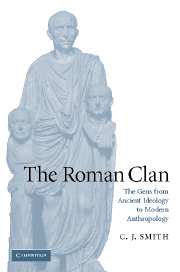Book contents
- Frontmatter
- Contents
- List of illustrations
- Preface
- List of abbreviations
- General introduction
- Part I THE EVIDENCE FOR THE GENS
- Part II TOWARDS AN INTERPRETATION OF THE GENS
- Appendix 1 Dionysius of Halicarnassus on the Roman curiae and religion
- Appendix 2 The missing curiae
- Select bibliography
- General index
- Index of ancient persons
- Index of passages discussed
Part I - THE EVIDENCE FOR THE GENS
Published online by Cambridge University Press: 22 September 2009
- Frontmatter
- Contents
- List of illustrations
- Preface
- List of abbreviations
- General introduction
- Part I THE EVIDENCE FOR THE GENS
- Part II TOWARDS AN INTERPRETATION OF THE GENS
- Appendix 1 Dionysius of Halicarnassus on the Roman curiae and religion
- Appendix 2 The missing curiae
- Select bibliography
- General index
- Index of ancient persons
- Index of passages discussed
Summary
The first part of this book focuses on the range of evidence which can be and has been brought to bear on the problem of the gens. We begin with the ancient evidence itself. What we know about the gens is actually confined to a few areas: inheritance, and various markers of identity such as burial grounds, legendary genealogies and religious rituals. One problem is that it is very difficult to find specific aspects of the gens which are not shared with many other social groups, so that what makes the gens different is elusive. The absence of a political dimension is also striking. The sources do not describe the gens as a political unit, though it is clear that members of gentes participate in political life in various ways; this will be the focus of the second part of this book. What is important here is to note that one source, Livy, indicates that an argument could be made that the gens was an institution which was possessed only by patricians. At the same time, our analysis of the evidence indicates the difficulty of making that argument with any cogent force, and indicates equally the existence of clear counter-indications, including evidence for non-patrician gentes, and definitions which are at variance with a patrician monopoly. The evidence does not give a single, straightforward picture, and my argument will be that this reflects ancient realities.
- Type
- Chapter
- Information
- The Roman ClanThe Gens from Ancient Ideology to Modern Anthropology, pp. 9 - 11Publisher: Cambridge University PressPrint publication year: 2006

